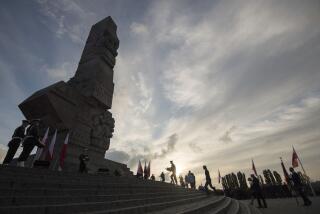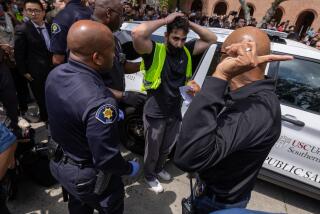U.N. Investigators in Bosnia Dig to Unearth Proof of a Massacre
KAMENICA, Bosnia-Herzegovina — The skeleton flops, like a tattered rag doll, as it is placed in a white body bag and taken away by investigators digging through a new find--one of Bosnia’s many hidden mass graves.
A team of 30 forensic specialists, international detectives and anthropologists chips away at sunbaked dirt to recover victims of what human rights officials have called the bloodiest atrocity in Europe since World War II: the fall of the city of Srebrenica in the summer of 1995.
It is not the first exhumation of mass graves holding Srebrenica victims. But this dig in a rural valley in eastern Bosnia-Herzegovina will almost certainly answer the most troubling mystery surrounding the massacre, which some investigators have privately referred to as “a genocide without corpses.”
More than 7,000 Muslim men and boys disappeared when the enclave was overrun by Bosnian Serb gunmen in July 1995. They were presumed to have been shot to death, but only a few hundred bodies were recovered.
Now, investigators believe they have discovered so-called secondary graves--made when Bosnian Serbs, trying to hide the evidence of what they had done, transported truckloads of corpses from where they were buried initially to better-concealed fields.
But U.S. spy satellite photography detected the new sites. And in the weeks to come, U.N. war crime teams hope to compile damning evidence against Bosnia’s most notorious war crime suspects.
The killings at Srebrenica are the basis for one of two genocide indictments against Radovan Karadzic, the Bosnian Serbs’ wartime president, and his military commander, Gen. Ratko Mladic.
At least 10 mass graves have been pinpointed along a roughhewn road that winds and dips through this sparsely populated valley dotted by bright purple wild irises. The jagged ruins of Muslim villages lie nearby, but several Serbian villages on the wooded ridge above the valley appear unscathed.
Exhumation of one site began in mid-May and yielded a tangle of about 90 bodies, according to officials of the International Criminal Tribunal for the Former Yugoslavia, which is prosecuting war crime suspects. Work at a second site began at the end of May.
The site is about 4 1/2 miles from a main road that runs north-south along the Drina River in Bosnian Serb territory, and about five miles southwest, as a crow flies, of the Bosnian Serb city of Zvornik, on the border with Yugoslavia.
After first inspecting the makeshift grave for land mines, investigators wearing rubber gloves and blue work pants toiled away with shovels and trowels one recent day. They dug through layer beneath layer of earth, removing more than a dozen bags of human remains and other evidence--bones, clay-caked clothing, personal effects.
The fall of Srebrenica, a U.N. “safe haven” that in the end the West did not protect, was one of the darkest chapters of Bosnia’s 3 1/2-year war. Bosnian Serb gunmen under the personal direction of Mladic rounded up thousands of men and boys, many of whom were summarily executed, according to survivors. More than 7,000 remain missing.
The first three main graves believed to be holding Srebrenica victims were exhumed in the spring of 1996, but investigators discovered that the graves had been robbed. In all, only about 450 bodies were recovered.
“The question was, where did they go? What happened to the bodies?” U.N. spokeswoman Kelly Moore said. “We are hoping [the new exhumations] will shed light on that.”
Investigators believe that the Bosnian Serbs, using backhoes and trucks, unearthed the bodies they had buried near the execution sites and transported them here and to other nearby areas. The investigators will use archeological and forensic evidence--shell casings, bullets, soil samples, for example--to try to link the original and subsequent burial sites.
U.S. soldiers belonging to the NATO peacekeeping force stationed in Bosnia give 24-hour protection to the graves and the team of investigators. Wearing bulletproof vests and with 9-millimeter Baretta pistols strapped to their chests, they sleep in their Humvees and maintain vigil over the dig.
“If we weren’t here, there’s no doubt this would be tampered with,” said Staff Sgt. Michael Contreras, 28, of Los Angeles. “It’s our job, and it’s worth it so they can feel safe.”
Contreras said the experience is gratifying for his troops, members of the U.S. Army’s 10th Mountain Division, who normally would be tied down to the air base in Tuzla that serves as American headquarters.
“It’s the first chance for the guys to see a little bit of why they’re here,” he said.
In the past, the North Atlantic Treaty Organization’s reluctance to guard the sites imperiled the larger exhumation project and led to accusations that Bosnian Serbs were able to tamper with graves and hide evidence practically under the noses of U.S.-led peacekeeping troops.
Tribunal officials insist that all of the tampering took place between July 1995 and late November or early December of that year, when peace accords drafted in Dayton, Ohio, ended the Bosnian war. That assertion, if true, would presumably relieve the U.S. military of blame, because NATO did not fully deploy in Bosnia until January 1996, and aerial surveillance of the sites had not yet commenced.
But reporters from this and other newspapers who first inspected some of the Srebrenica graves in April 1996 found evidence of recent tampering that had apparently occurred after that winter’s snow melted.
Tribunal officials also appear reluctant to answer the question of why, if the secondary graves were detected in 1996, as appears to be the case, it took nearly two years for the digs to begin. Lack of funding and security guarantees are among the reasons cited for the delay.
If large numbers of bodies are recovered now, as investigators expect, the evidence will be used to bolster indictments already handed up and possibly substantiate new ones.
To the likely dismay of the still-traumatized survivors of Srebrenica, however, there will be only limited efforts to identify the remains, tribunal officials say.
More to Read
Sign up for Essential California
The most important California stories and recommendations in your inbox every morning.
You may occasionally receive promotional content from the Los Angeles Times.











